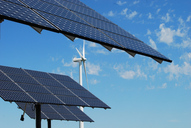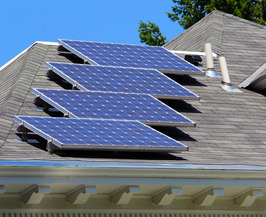
Clean Energy News
 Renewable Energy Report: More than 22% of Minnesota's electricity came from renewables in 2016
Minnesota
generated more than 22% of its electricity from renewable energy sources in
2016, up from less than 7% a decade earlier, according to “Minnesota Renewable Energy Year in
Review 2016” (pdf), a report
by the Minnesota Department of Commerce. The latest number puts the state well
on pace to exceed its current Renewable Electricity Standard of 25% by 2025.
Minnesota generated electric power from nearly 4,500 megawatts (MW) of renewable-fueled
sources in 2016. In the past decade, energy generated by renewables has more
than tripled in Minnesota, while dependence on coal has declined significantly.
Wind energy alone generated 17.7% of the state’s electricity last year, compared
to just 3.9% in 2006. Meanwhile, electricity from coal dropped from 62% to 39%
during the same period. Read more.
|
A first: Wind, solar make up 10% of U.S. electricity generation in March
For the first time, monthly electricity generation from wind and solar (including utility-scale plants and small-scale systems) exceeded 10% of total electricity generation in the United States, based on March data in the U.S. Energy Information Administration’s Electric Power Monthly. Electricity generation from both of these energy sources has grown with increases in wind and solar generating capacity. On an annual basis, wind and solar made up 7% of total U.S. electric generation in 2016. Read more.
CERTs to roll out Renewable Energy for
Greater Minnesota II program
In mid-July, the
Minnesota Clean Energy Resource Teams (CERTs) will roll out the "Renewable Energy for Greater
Minnesota II" program that will run through September 2019.
A USDA Renewable Energy Development Assistance grant enables CERTs to perform
small wind site assessments for Minnesota farms and small businesses and help people
through the Rural Energy for America Program (REAP) or other funding mechanism
process. A fact
sheet about the program is available. If you would like to discuss a potential
project, email Fritz Ebinger or call him
at 612-626-1028.
Energy Policy Legislation
 New legislation rescinds Made in Minnesota Solar Incentive Program
Legislation from
the 2017 Minnesota legislative session repealed the final six years of the
10-year Made in Minnesota Solar Incentive
Program. Commerce will continue
to administer the annual performance-based incentive payments that are due to
recipients from the first four years of the program, but the program will not
take new applications for the final six years.
The new
legislation requires that all Made in Minnesota projects must begin generating
electricity no later than Oct. 31, 2018 to be eligible for incentive payments. Questions from current program recipients may
be directed to the Solar Helpline at solar.help@state.mn.us and 651-539-1886 (local) or 800-657-3710 (Greater Minnesota).
The Made in
Minnesota Solar Incentive Program is administered by the Minnesota Department
of Commerce and was open to customers of investor-owned electric utilities (Xcel Energy, Minnesota Power, and Otter
Tail Power). The program was established by Solar Energy Legislation (pdf) passed in 2013 to stimulate the
solar industry. It supported about 1,800 solar projects and more than 25
megawatts of new capacity during its four years. Total annual projects and
capacity increased from 363 projects and 5 MW in 2014 to 697 projects and 10.22
MW of capacity this year.
Made in Minnesota was particularly
effective in terms of expanding Minnesota's total solar capacity during its first two years, before large
utility-scale and community solar gardens started generating significant amounts
of electricity in 2016 and 2017. For instance, the Made in Minnesota program
added about 10 MW in its first two years when total capacity for the state was
at just 15 MW in 2013.
Made in Minnesota stimulated
solar jobs as well. From 2013-2015, 1,131 solar jobs in Minnesota were created for a
131% increase over 2012 totals, due in part to the Made in Minnesota program.
Solar jobs increased 44% from November 2015 to November 2016, according to the 2016 National Solar Jobs Census. Minnesota employed 2,872 people in the
solar industry as of Dec. 31, 2016, up from 1,995 the year before. An estimated
500 Minnesota companies conduct solar manufacturing, sales, distribution, and
development and installation functions.
Solar incentives, tax credits still available
The Legislature
extended Xcel Energy’s Solar*Rewards Program for three years and increased its
funding to $15,000,000
in 2018, $10,000,000 in 2019 and 2020, and $5,000,000 in 2021. Like Made in
Minnesota, the Solar*Rewards Program provides recipients with 10 years of annual
incentive payments based on the solar energy system’s annual production.
Solar*Rewards had annual funding of $5 million appropriated beginning in 2014,
and it awards customers on a first-come, first-served basis. With other utility
solar incentive programs and the 30% federal Residential Renewable Energy Tax Credit still in place through 2019,
there is still strong incentive for Minnesota residences and businesses to go
solar.
Other notable legislation: 50 electric cooperatives, municipal
utilities exempt from CIP requirements
Twelve electric
cooperative utilities and 38 municipal electric utilities in Minnesota are now
exempt from Conservation Improvement Program (CIP) requirements, according to
legislation signed into law on May 31. Electric co-ops serving less than 5,000
members and municipals serving less than 1,000 retail electric customers are
affected. The exempted co-ops and municipal utilities can determine if they
want to continue CIP programming and reporting CIP performance and plans.
Utilities should contact CIP’s Jessica Burdette or Anthony Fryer with questions.
Read
more about Energy Policy Legislation under Article
10 of
Chapter 94.
|
Solar News
Solar photovoltaic installer is the
fastest-growing job in United States
Solar photovoltaic
installer--or workers who maintain, assemble and install solar panels--was the
fastest-growing job in the United States, according to Bureau of Labor Statistics compiled by
SmartAsset. The rate of growth was 88.3% from 2012 to 2016, compared to an average of 4.9% for 675 occupations analyzed. Read more.
Berkeley Lab helps real estate agents,
home buyers value solar homes
Because solar
has been found to consistently add value to homes, real estate agents need a
new way to fairly value solar homes and make sure house hunters can easily find
key solar system information. With support from the SunShot Initiative,
Lawrence Berkeley National Laboratory set out to create data standards for
solar properties that can be used by the more than 700 multiple listing
services (MLS) around the country. Over the course of six months and several
meetings, Berkeley Lab and its partners developed standards for accurately
capturing key solar system characteristics in the MLS. Read more.
MREA offers free solar energy forums throughout
Minnesota
The Midwest Renewable Energy Association (MREA) is
partnering with cities and neighborhoods across the state to provide Solar Power Hour information forums on solar energy options. The free educational sessions feature
several topics including residential solar, community solar, and solar for your
business. They will discuss financial considerations, available incentives, and
how to go about selecting the right installer. The forums will be held:
- June
28, 6:30 p.m., Elk River Public Library in Elk River
- July
12, 7 p.m., Maplewood Community Center in Maplewood
- July
19, 7 p.m., Inver Grove Heights City Hall in Inver Grove Heights
- July
20, 7 p.m., Eden Prairie Community Center in Eden Prairie
- July
26, 4 p.m., Insight Brewing Co. in Minneapolis
Wind News
General Mills signs 15-year agreement
for 100 MW wind project
Minneapolis-based General
Mills has taken another step toward its climate goal with the signing of a
virtual 15-year power purchase agreement with Renewable Energy Systems (RES)
for 100 megawatts of its Cactus Flats wind project. The wind project will
produce renewable energy credits for General Mills that can be applied toward
the company’s greenhouse gas emission reduction goals. During the peak of
construction, the project will create about 250 jobs in the clean energy
workforce. General
Mills’ investment will help fund the construction of the 150-megawatt Cactus
Flats wind project being developed in Concho County, Texas. Read
more.
Electric Vehicles
CERTs reviews two websites to help the electric vehicle shopper
The Clean Energy Resource Teams (CERTs) offers guidance about two web resources for the electric vehicle (EV) shopper, mncharging.org and evsalespro.com. CERTs interviewed several EV experts, utility staff, and EV sales personnel to make EV shopping easier. Read the CERTs story.
Renewable News is a newsletter that covers a range of renewable energy topics, including innovative initiatives in our state, technological advancements, financial incentives, trainings, and events. If you would like to change preferences for the newsletters you are currently subscribed to or if you want to unsubscribe, please use the links at the bottom of this page.
|